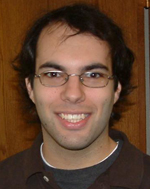DiSciacca ’07 First Author on Antiproton Paper

Jack DiSciacca ’07 is first author on a paper that appeared in the April issue of Physical Review Letters, a premier journal for physics. Now a Ph.D candidate at Harvard, DiSciacca earned his undergraduate degree with high honors; Foss Professor of Physics Tom Morgan was his advisor. The published paper, “One Particle Measurement of the Anti-Proton Magnetic Moment,” details DiSciacca’s research on the antiproton, which is an antimatter particle.
Morgan explains, “DiSciacca spent the last six months at CERN [the European Organization for Nuclear Research], at the same accelerator facility where physicists recently discovered the Higgs boson to measure the magnetic moment of the antiproton (how much spinning current this anti-matter particle possesses).”
DiSciacca’s work is significant because it offers experimental confirmation of a key theory in physics known as CPT – charge, parity, time invariance. His findings were cited for their importance in Physics Viewpoints, where Eric Hudson and David Salzberg from the University of California in Los Angeles wrote: “Specifically, Jack DiSciacca of Harvard University and his colleagues present the most precise measurement to date of the antiproton magnetic moment … As reported in Physical Review Letters, the results match data on the proton, thus extending CPT’s shatterproof status for the time being.”
Morgan also notes that DiSciacca recently visited his class to give a presentation on his work, which DiSciacca says was “really a discussion, with lots of questions and more of a dialog than a typical presentation.” He was pleased with the engaged quality of the students’ remarks and describes Wesleyan as “a spectacular place to do physics. You won’t find more committed teachers anywhere,” with an atmosphere that is relaxed and friendly, as well as highly academic. The professors, he says, are truly accessible.
As for his current work, DiSciacca says, “The process of making the antiproton measurement was quite interesting and also demanding. We had about six months to move almost everything we used at Harvard to Switzerland, install the experiment and make the measurement using a single antiproton. The goal was to make a measurement before the December 2012 start of an extended upgrade phase at CERN, where there would be no antiprotons for another year and a half. One interesting part of this process is the story of moving the experiment to Switzerland. We went from having an experiment that fits in a room at Harvard, to working in a Home Depot-sized building with many other experiments in close proximity.”
“Our experiment is rather tall, about my height, and it’s quite delicate. So, to secure it safely for the plane ride over, we found that it would exceed the height limit of planes leaving Boston. As a result, we had it trucked to JFK, flown to Paris on a larger plane, and then trucked from Paris to CERN. The fact that it arrived in one piece, without any broken components, continues to amaze me.”
See related links:
http://prl.aps.org/toc/PRL/v110/i13
http://link.aps.org/doi/10.1103/Physics.6.36

